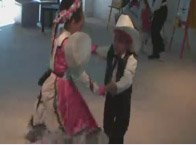 I just finished reading Eric Jensen’s book, Enriching the Brain: How to Maximize Every Learner’s Potential. Eric Jensen is a leading educator in the area of applying neuroscience research to practical classroom applications.
I just finished reading Eric Jensen’s book, Enriching the Brain: How to Maximize Every Learner’s Potential. Eric Jensen is a leading educator in the area of applying neuroscience research to practical classroom applications.
As I read, I kept reconsidering my reluctance to use the word enrichment in talking about videooconferencing. I prefer “curriculum videoconferencing” to emphasize the use of VC to meet curriculum goals. To me, enrichment sounded like an “extra”, like something expendable in high-stakes, tight-budget times.
What is Enrichment?
But then, all through the book, I kept encountering Jensen’s insistence that all students need to experience enrichment. What does he mean? First, it’s important to understand his definition:
Enrichment is a positive biological response to a contrasting environment, in which measurable, synergistic, and global changes have occured (Jensen, 2006, p. xii).
A careful read of the book shows the importance of understanding that enrichment is the response to a contrasting environment, not just decorating an “enriching environment.” Enrichment is what happens to the brain in a contrasting environment. I encourage you to devour this book to understand this fully.
So, what is a contrasting environment?
A contrasting environment is where the student experiences a “contrast” from what he or she is usually getting. There are seven factors or maximizers for contrasting environments. They are:
- Physical Activity (voluntary gross motor)
- Novel, Challenging, and Meaningful learning
- Coherent Complexity (not chaotic)
- Managed Stress Levels (not boring or distressful)
- Social Support (at home, school, and community)
- Good Nutrition (balanced and healthy with supplements)
- Sufficient Time (not rushed, plenty of sleep) (Jensen, 2006, p. 178).
Jensen’s suggestions for whole district improvement are way beyond anything that I can impact in my work – eliminating grade levels, 20-30 minutes of recess daily, pull out programs, acceleration, student choice, exploratory learning, social connectedness, etc. He describes a major change to traditional schooling. While it’s inspiring, it’s beyond the scope of my current work at least right now.
Novel and Meaningful Learning
Thankfully, he also has suggestions for teachers and principals. The one that seems to be in an area that I can impact is that of Novel, Challenging, and Meaningful Learning.
- Have you ever wondered if kids like VC just because it’s novel? Why is it that Monster Match is such a great relief from Michigan state testing and Read Around the Planet relief from NY and TX state testing? Could it be because it’s a contrast from their regular work?
- Why is it that teachers comment especially on the reaction of special education kids in a videoconference? Why do special ed kids gain a lot from a videoconference? Could it be because it’s a contrast from their regular experiences? Interestingly, Jensen spends quite a bit of time on how at-risk, poverty-challenged kids can benefit greatly and make significant gains in learning when they are in a contrasting environment.
- Is it actually a good thing for students’ brains that VC is novel? that it connects them to real-world meaningful learning, we agree already. But novel?! I thought that novel was kind of a bad word in education, that an innovation should be sustainable, sustained, institutionalized.
Don’t misunderstand me or Jensen! Short one time VCs are hardly a drop in the bucket of the contrasting environment that students need. Be sure you understand the huge scope of what he is suggesting.
Still, I think we can take away a small application by understanding that the novelty and real-world connection of a curriculum-based videoconference is stimulating to students’ brains! (Talking to an author, talking to kids in Australia, Canada, or Wales, interacting with scientist… that’s all real-world.) Probably not enough to make a significant (countable, measurable) difference; but yet another little tool in the teacher’s arsenal of tools for creating a contrasting environment for students.
What do you think? Have you read Jensen’s work? Am I off base? Is it too much of a stretch to apply this, even in a small way, to the use of videoconferencing? Are you going to use the word enrichment or “contrasting environment” when describing VC? Please comment!


 Today we have a couple more sessions with
Today we have a couple more sessions with 
 Today’s the first day of
Today’s the first day of  Just a quick heads-up for those of you who like to participate in the
Just a quick heads-up for those of you who like to participate in the  Today we participated in an exciting interview with
Today we participated in an exciting interview with  Did you know
Did you know